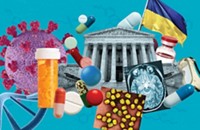Advertisement
Grab your lab coat. Let's get started
Welcome!
Welcome!
Create an account below to get 6 C&EN articles per month, receive newsletters and more - all free.
It seems this is your first time logging in online. Please enter the following information to continue.
As an ACS member you automatically get access to this site. All we need is few more details to create your reading experience.
Not you? Sign in with a different account.
Not you? Sign in with a different account.
ERROR 1
ERROR 1
ERROR 2
ERROR 2
ERROR 2
ERROR 2
ERROR 2
Password and Confirm password must match.
If you have an ACS member number, please enter it here so we can link this account to your membership. (optional)
ERROR 2
ACS values your privacy. By submitting your information, you are gaining access to C&EN and subscribing to our weekly newsletter. We use the information you provide to make your reading experience better, and we will never sell your data to third party members.
Pharmaceuticals
Pharmaceuticals Issue
by Rudy M. Baum
September 28, 2009
| A version of this story appeared in
Volume 87, Issue 39
THIS WEEK'S ISSUE is C&EN's annual pharmaceuticals issue, timed in part to coincide with the CPhI conference to be held in mid-October in Madrid. The issue will be distributed to conference attendees at C&EN's booth at CPhI.
The cover package of two stories by Senior Correspondent Ann Thayer focuses on the effort against the novel H1N1 flu virus that emerged, seemingly out of nowhere, earlier this year. In June, the World Health Organization declared the 2009 H1N1 virus a "level 6 pandemic," meaning that a new virus not previously circulating in humans is being rapidly transmitted.
So far, the flu symptoms caused by the novel H1N1 virus are relatively mild and clear up in about a week without any treatment. Still, as Thayer writes, "The new virus causes more healthy young people to get sick and even die, compared with seasonal flu." And because no one has any immunity to the virus, WHO estimates that as many as 2 billion people could become infected over the next two years.
In the first of the two cover stories, Thayer examines in depth the massive effort by drug companies and governments to develop drugs to treat novel H1N1 infections. Although symptoms associated with the virus have been relatively mild so far, that doesn't mean that the virus won't potentially mutate into a more virulent form. As Thayer writes, "The winter flu season in the Northern Hemisphere is beginning, and the unpredictable virus and its unexpected epidemiology have public health agencies hoping for the best but preparing for the worst."
Of the four antiviral flu drugs that are available, novel H1N1 is resistant to two, leaving only GlaxoSmithKline's Relenza and Roche's Tamiflu available to treat patients. Thayer outlines the truly Herculean efforts that are being made to produce sufficient amounts of these drugs to treat the potential cases. Thayer also discusses the intense research being done on new antiflu drugs, ones that have a mechanism of action similar to that of Relenza and Tamiflu and ones that attack the virus in new ways.
In the second cover story, Thayer writes about the effort to produce sufficient quantities of vaccine against the novel H1N1 virus. "Racing against the clock," Thayer writes, "vaccine developers have succeeded in making an effective vaccine against the novel H1N1 virus. Although worldwide capacity for the vaccines is conservatively pegged at 1 billion to 2 billion doses per year, according to WHO, only a fraction will be ready for distribution before the flu pandemic peaks."
While Thayer's cover stories are the core of the pharmaceuticals issue, the centrality of pharmaceuticals, biotechnology, and medical issues generally to the chemistry enterprise is demonstrated by the fact that five other major stories in this issue touch in one way or another on medical topics.
In the Business Department, Senior Editor Rick Mullin looks at what many may find to be a surprising trend: Drugmakers are reassessing their supply chains and turning to U.S.-based chemical manufacturers for synthesis of their active pharmaceutical ingredients. For many years, it has seemed that API manufacture was inexorably moving to low-cost producers in China and India, but as Mullin points out, some of those low costs were illusory. Another story in the Business Department by Senior Editor Lisa Jarvis is on development of small-molecule drugs to treat dry age-related macular degeneration.
Both Government & Policy Department stories in the issue touch on drugs or medical issues. Senior Editor Glenn Hess writes on victories in Congress by makers of brand-name biologics to have 12 years of exclusivity before generic versions can come to market. And Associate Editor Britt Erickson discusses the questions surrounding direct-to-consumer genetic tests.
In the Science & Technology Department, Senior Correspondent Stu Borman looks at the challenges faced by drug developers targeting disease-related RNAs.
There is more to the chemistry enterprise than pharmaceuticals and medicine, of course, and most issues of C&EN are not so heavily weighted toward these topics. It's appropriate, though, that our annual pharmaceuticals issue highlights the importance of this element of our enterprise.
Thanks for reading.
Rudy Baum
Editor-in-chief
Views expressed on this page are those of the author and not necessarily those of ACS.



Join the conversation
Contact the reporter
Submit a Letter to the Editor for publication
Engage with us on Twitter